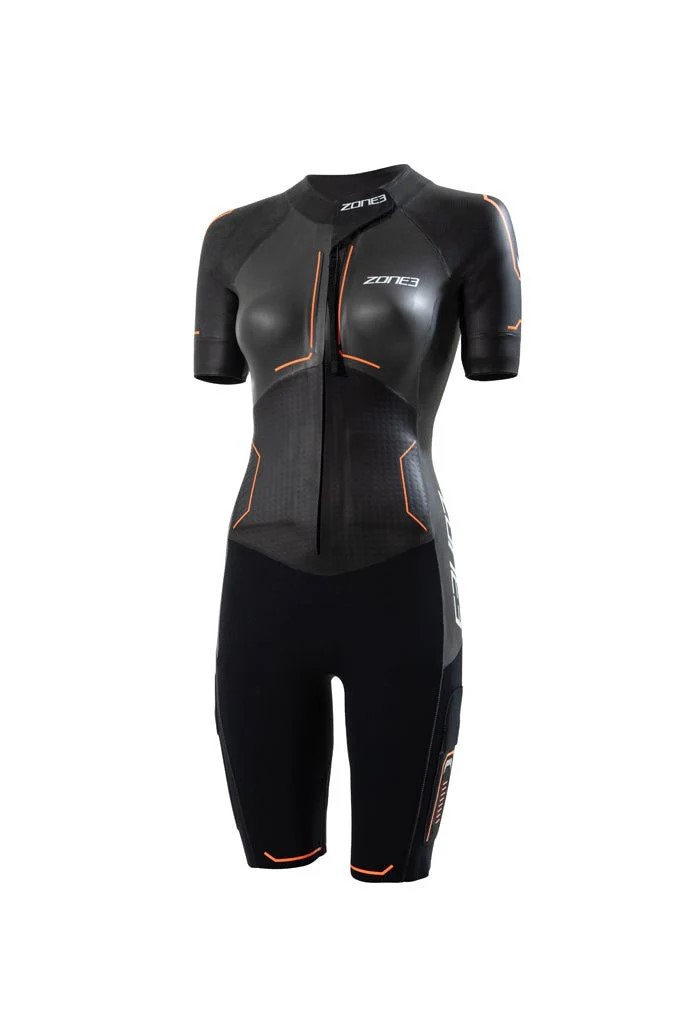Discover the Thrill of SwimRun: A Multi-Sport Adventure
 Karen Parnell
February 04, 2025
Karen Parnell
February 04, 2025
Discover the Thrill of SwimRun: A Multi-Sport Adventure
SwimRun is an exciting and unique endurance sport that combines open-water swimming and trail running in a seamless, continuous event.
Unlike traditional triathlons or Aquathlons, where transitions separate disciplines, SwimRun requires athletes to alternate between swimming and running multiple times, often with a partner, navigating through natural landscapes.
Originating in Sweden with the famous ÖTILLÖ race, this sport has grown internationally, offering a dynamic challenge for athletes of all levels.
In this Blog we will look at the format and distances, how to train for a SwimRun, the kit required, popular global races and cover frequently asked questions.
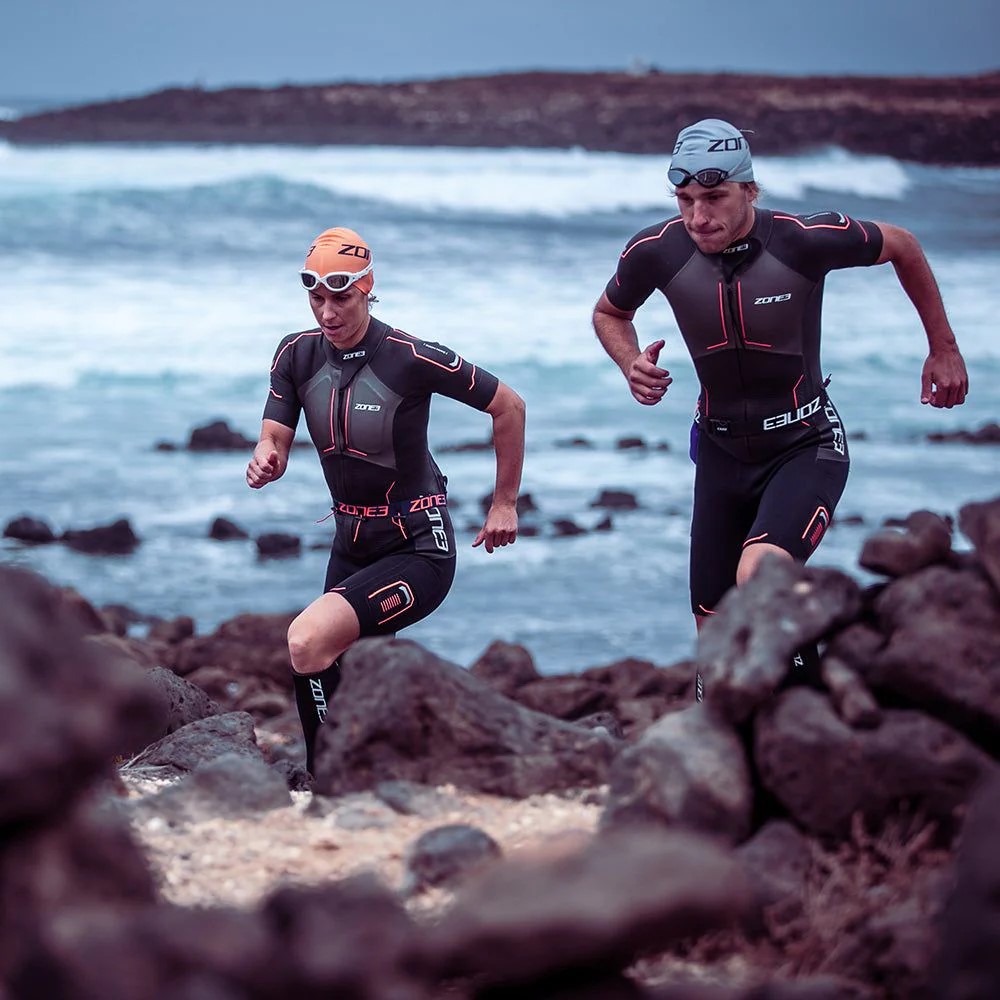
Source: Zone 3
Get your FREE Open Water Swimming Sessions E-Book
SwimRun Plans on TrainingPeaks
SwimRun Formats and Distances
Race Format
SwimRun events are held in stunning natural environments, such as coastal regions, lakes, and archipelagos. Competitors follow a course that alternates between trail running and open-water swimming, requiring seamless transitions between the two disciplines.
Unlike traditional triathlons, which feature distinct swim and run stages, SwimRun races demand continuous movement between land and water, introducing an extra layer of strategy and challenge.
Many SwimRun races are completed in teams of two, with partners tethered together during swim segments for safety and teamwork. Participants navigate rugged terrains, adapt to changing water conditions, and tackle transitions that may involve scrambling over rocks or weaving through dense forests.
SwimRun events vary in distance, terrain, and difficulty. Most races fall into three main categories:
SwimRun Distances
- Short Distance (Sprint): Typically, between 10-15 km total, with multiple short swim segments ranging from 200 to 800 meters. Ideal for beginners.
- Standard Distance (Middle): Covers 20-35 km, with swim sections up to 2 km, requiring greater endurance.
- Long Distance (Ultra/Full ÖTILLÖ): Often exceeding 50 km, with extensive swim segments, demanding peak fitness and teamwork.
Some events, like the ÖTILLÖ World Championship, require athletes to race in pairs, emphasizing teamwork, strategy, and communication.
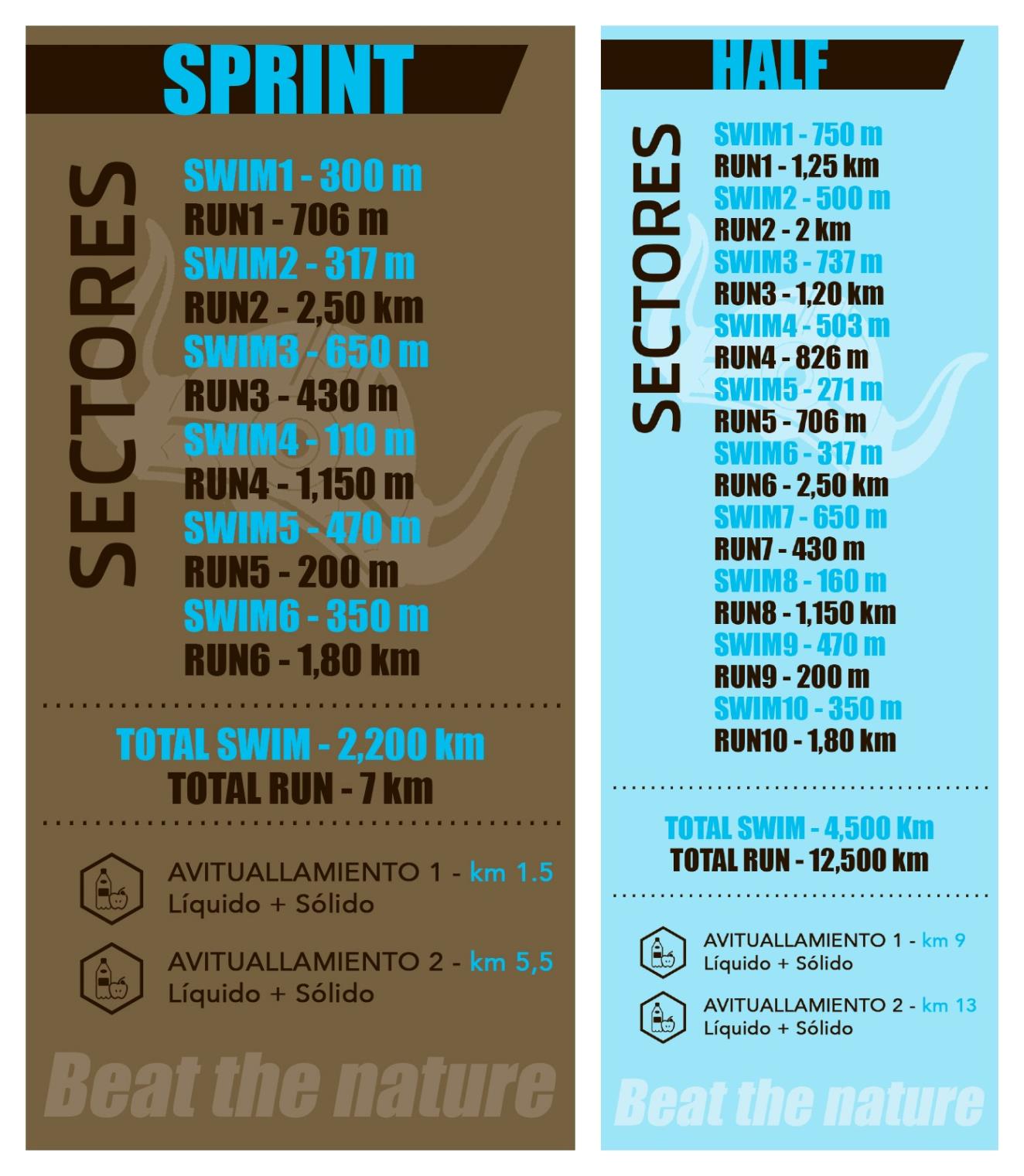
Example SwimRun Race Distances and Segment for the Costa Azahar Race in Spain.
Get your FREE Swim Workouts for Triathletes E-book
Training for SwimRun Success
Training for SwimRun requires a blend of endurance, strength, and technical skills. Here are key components:
1. Swim-Run Bricks: Unlike triathlon, you’ll be swimming in shoes and running in a wetsuit. Training with repeated swim-run transitions will help you adapt.
2. Open-Water Proficiency: Pool swimming is great, but train in open water to handle waves, currents, and sighting.
3. Trail Running Mastery: Most races feature off-road terrain, so practice running on uneven surfaces to build agility.
4. Partner Practice: If racing as a team, train together to synchronize pace, practice tethering (if used), and refine your strategy.
5. Strength and Mobility: Core and leg strength are vital for endurance, while mobility training helps with transitions.
6. Practice Transitions: Regularly practice transitioning between running and swimming to improve efficiency and reduce time spent changing gear. Simulate race conditions by practicing on different surfaces and in various water entry and exit scenarios.
7. Simulated Race Sessions: Periodically simulate the race distance or segments to assess your overall readiness.
8. Equipment Familiarity: Train with the gear you’ll use in the race, including wetsuit, swim cap, goggles, trail running shoes, and any optional swim aids. Ensure your gear is comfortable and doesn’t cause chafing over extended periods or when wet. Test your equipment and nutrition strategy during these sessions.
9. Rest and Recovery: Schedule rest days to prevent overtraining and reduce the risk of injuries. Incorporate stretching, foam rolling, and other recovery techniques into your routine.
10. Mental Preparation: Practice mental resilience and adaptability during training to cope with the challenges of race day. Visualize success and develop a positive mindset.
11. Race Simulation: Before the event, perform a race simulation, including transitions and nutrition strategy, to identify and address any potential issues.
Gradually increase the intensity and duration of your training to build endurance and strength effectively. Seeking guidance from a coach or an experienced SwimRun athlete can provide valuable, personalized insights. Consistency and a varied training routine are essential to preparing for the diverse challenges of a SwimRun event.
If you would like a structured training plan you can find them on TrainingPeaks and Final Surge.
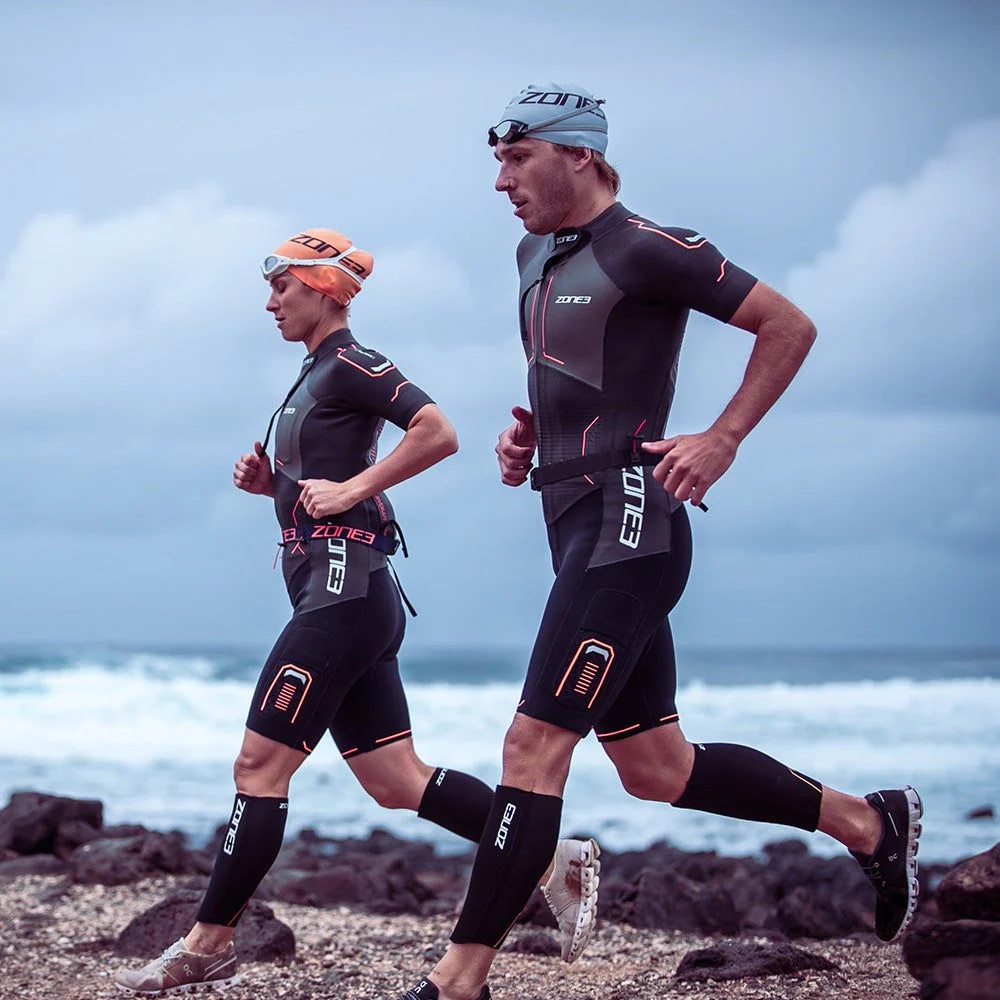
Get your FREE Open Water Swimming Sessions E-Book
SwimRun Plans on TrainingPeaks
Essential SwimRun Gear
SwimRun athletes must be equipped for both land and water challenges, requiring specialized gear to optimize safety and performance. Essential items include a wetsuit designed for both swimming and running, lightweight trail shoes with superior drainage, and a tow line to connect teammates during swim segments.
Many participants also use paddles and pull buoys to enhance swimming efficiency, while some races permit the use of fins.
Gear requirements can vary based on the specific race and its conditions, highlighting the need for adaptability. To manage the continuous transitions between disciplines, key equipment includes:
SwimRun Wetsuit
Flexible, short-legged wetsuits with front zippers allow for easy ventilation and movement. These are different from triathlon or open water wetsuits as you need to run in them. A good example of a SwimRun wetsuit is the Evolution from Zone 3. It is specifically designed for SwimRun events and has 6 pockets, is lightweight and has removable arm sleeves.
The Zone3 Evolution SwimRun Wetsuit designed to swim and run in.
Get your FREE Open Water Swimming Workouts E-Book
Lightweight Running Shoes
Quick-draining shoes with good grip for trail running are essential. Your shoes will get wet so choose a shoe with holes in the soles to allow for water drainage. You should also consider running sockless as they will get wet and can cause blisters.
The shoes from Inov8 like the X-Talon are good choice and if you prefer barefoot shoes then the Vivobarefoot Tempest are worth a look. I like to use the Tropicfeel running shoes are they are waterproof, have drainage holes and are made from recycling bottles.
TropicFeel Running Shoes you can Swim in with water drainage holes.
Get your FREE Guide to Running Speed and Technique
SwimRun Plans on TrainingPeaks
Hand Paddles and Pull Buoy
Yes, you can use both hand paddles and pull buoys in SwimRun events!
But you do have to consider how you will run with them. You can run with the paddles on your hands but do practice this during training as you may need to choose smaller oner.
The pull buoy can be strapped to your leg and put to the outside of your leg when you run and then rotated around to the centre when you swim.
Often these two pieces of kit are used to enhance swim efficiency while managing the impact of swimming in shoes.
The Power Stroke from Zone3 are a good option as they are comfortable and lightweight with straps, so you won’t lose them as you run.
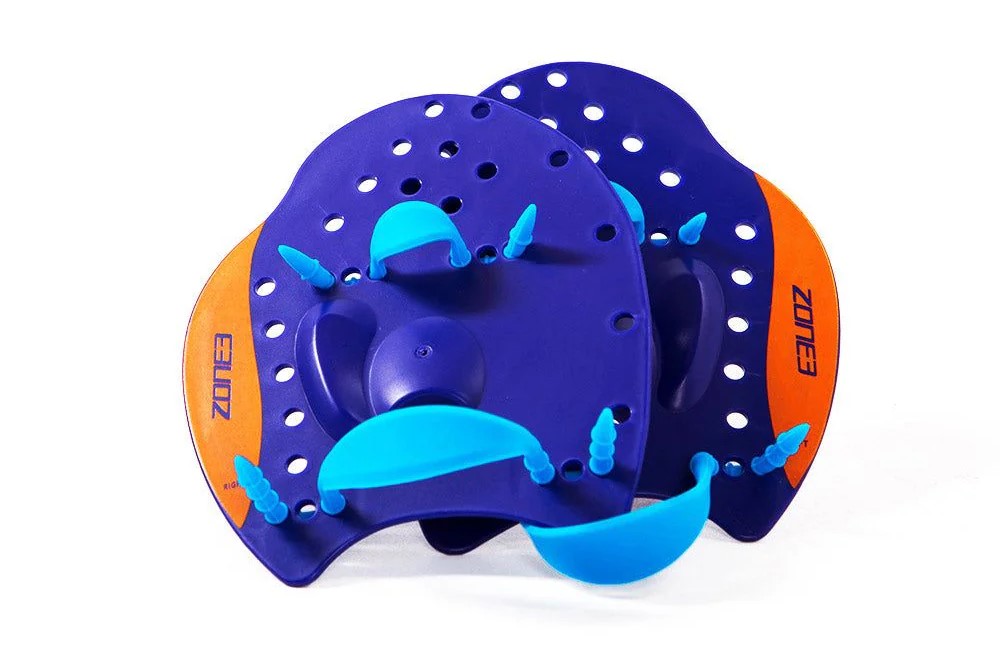
Zone3 Powerstroke Hand Paddles with Strap
It’s advisable to use a pull buoy to keep your hips, legs and feet high in the water as your shoes may cause drag. The Nu SwimRun Orza pull buoy is an excellent choice as it has been specifically designed for SwimRun races and has a leg cord.
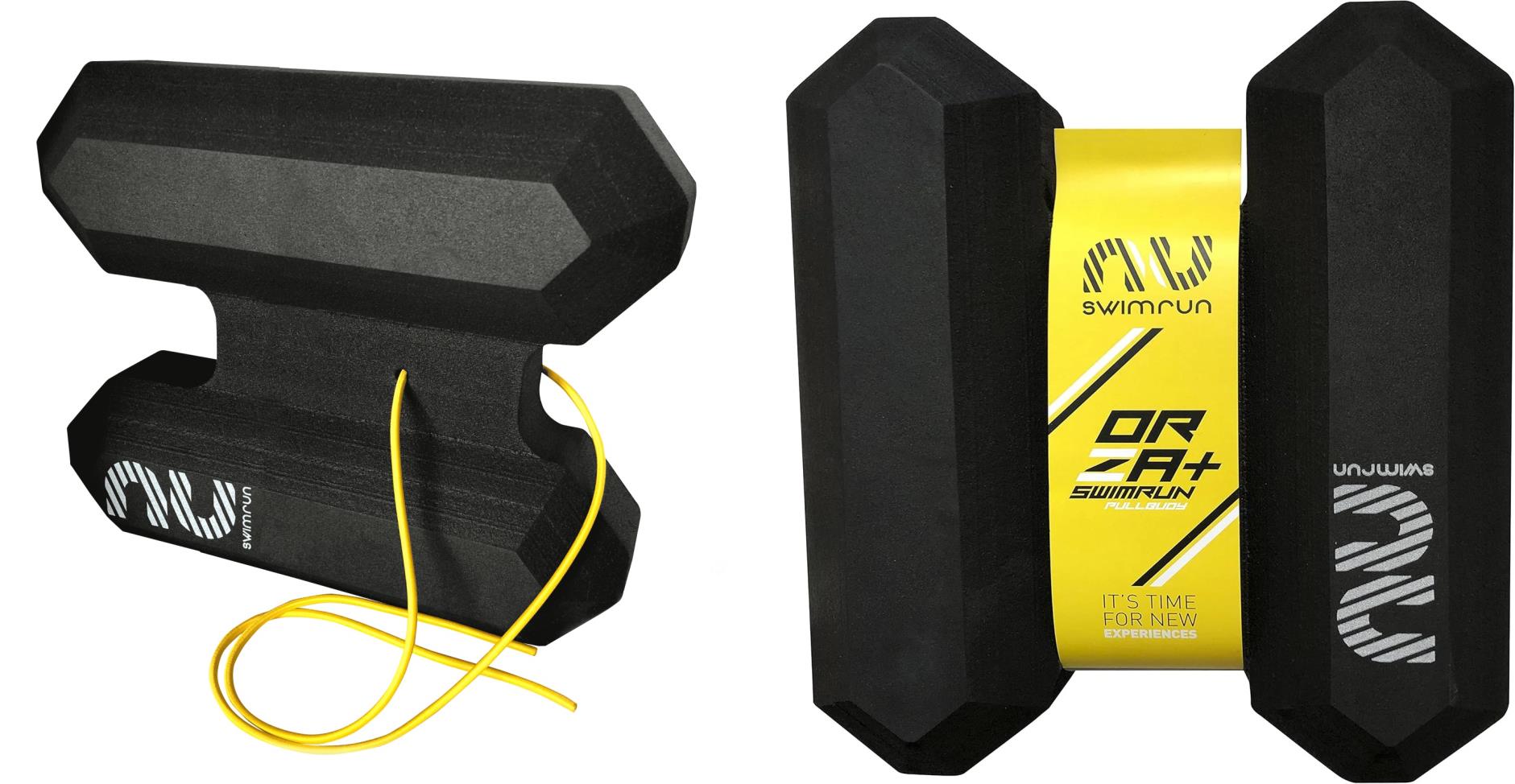
The Orza SwimRun Pull Buoy with leg cord.
Get your FREE Guide to Running Speed and Technique
SwimRun Plans on TrainingPeaks
SwimRun Tether (for Team Races)
Helps maintain a consistent pace and navigate efficiently in the water. You can get these in Decathlon.
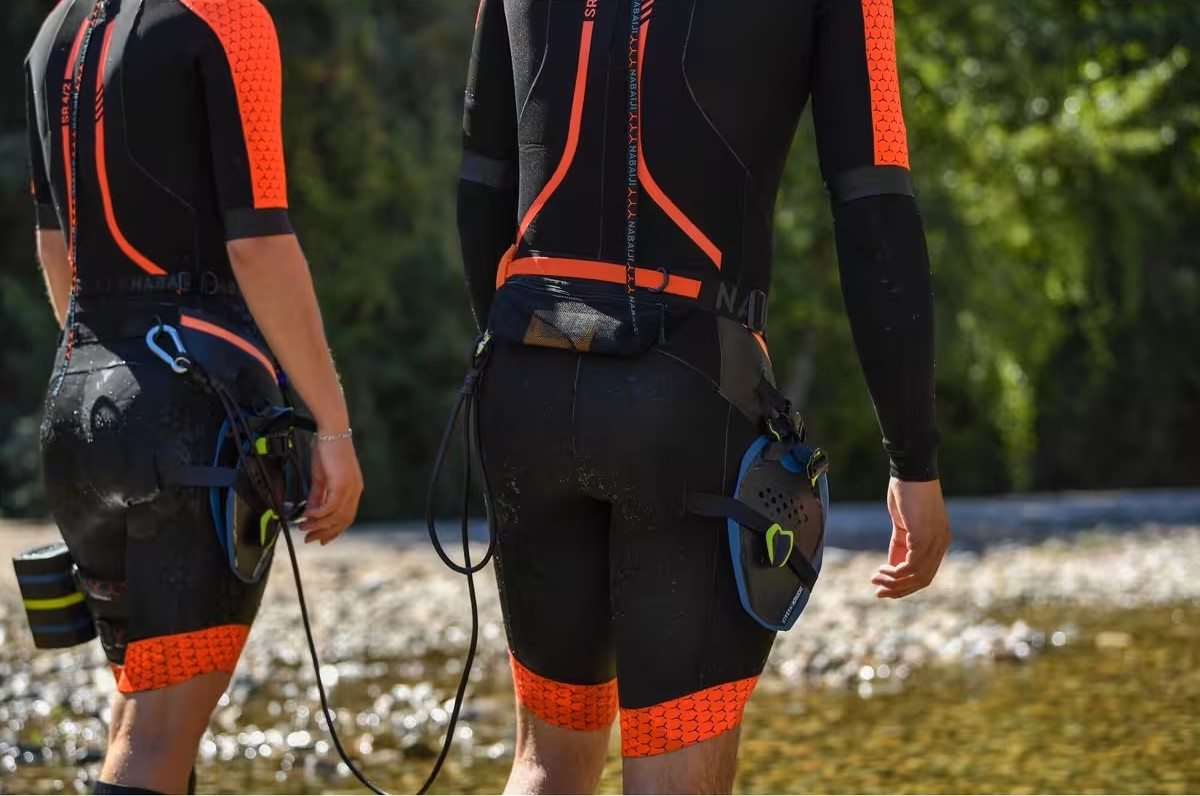
Decathlon SwimRun Tether Cord
Get your FREE Open Water Swimming Sessions E-Book
SwimRun Safety Gear and Tow Float
Some races require whistles, compression bandages, or GPS trackers for safety. You should check the race pack to see what you need to take with you and how you will carry the kit. Carry kit in a tow float with dry pack section is the best idea.
For the tow float the Lomo SwimRun rucksack is a good option or the recycled 2 led backpack from Zone 3. The Swim Secure wild swim bag is the one that I have.
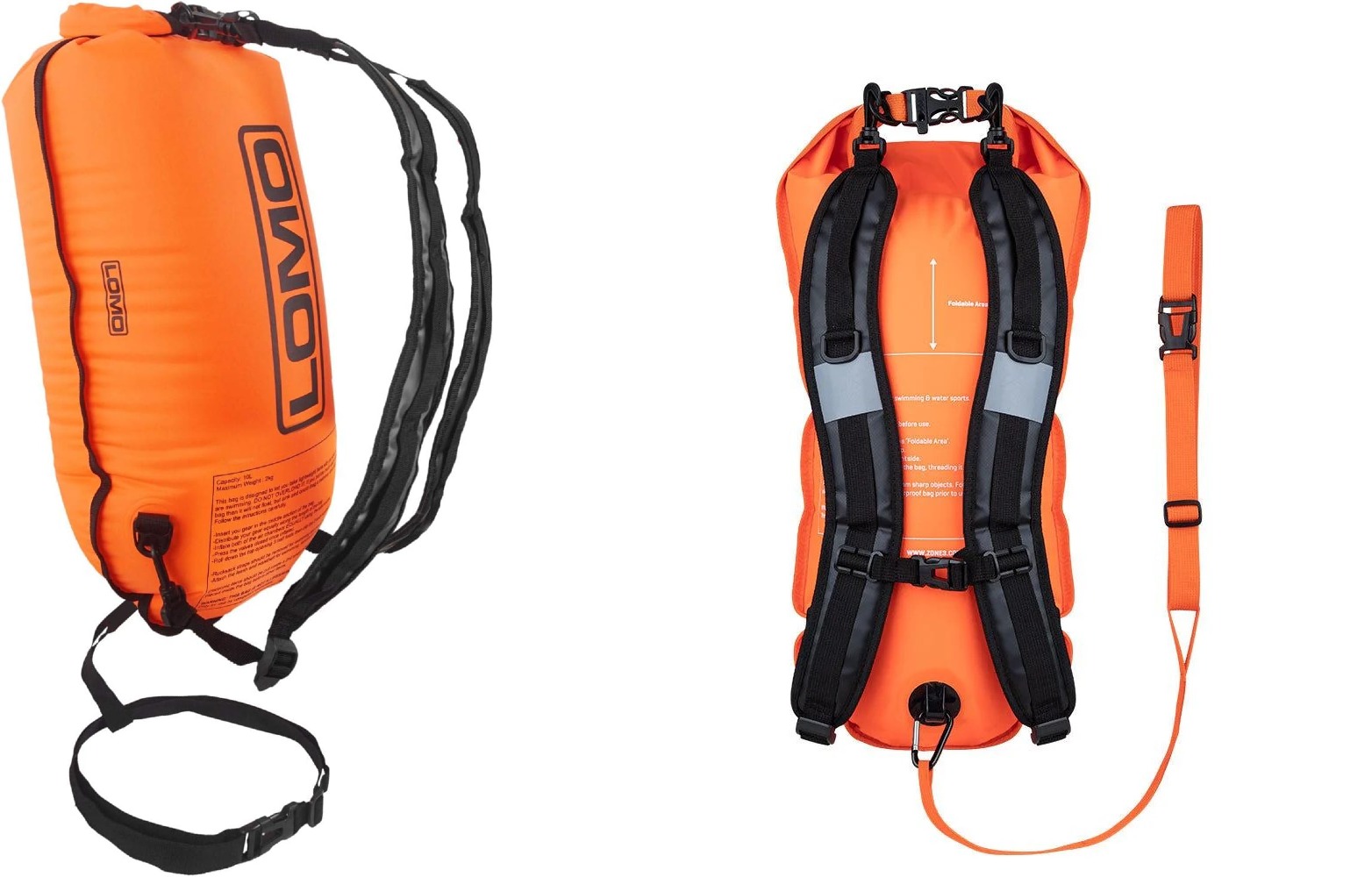
Lomo and Zone3 Rucksack Tow Floats ideal for SwimRun Events
SwimRun Plans on TrainingPeaks
SwimRun Goggles and Fins
Surprisingly fins are also allowed in some SwimRun races, and these will help with your propulsion. Fins can be quite bulky so before committing to them consider how you will carry them as you run.
Goggles are a bit consideration, and I have listed my favourites in this Blog on open swimming goggle selection.
Conclusion: Why You Should Try SwimRun
SwimRun is an exhilarating test of endurance, adaptability, and teamwork, immersing you in nature like no other sport.
Whether you’re an experienced triathlete looking for a new challenge or a newcomer seeking adventure, SwimRun offers a fresh and rewarding experience.
With the right training, mindset, and gear, you can dive into this incredible sport and push your limits in a fun and supportive community.
Are you ready to take the plunge and hit the trails? Start your SwimRun journey today!
Karen Parnell is a Level 3 British Triathlon and IRONMAN Certified Coach, 8020 Endurance Certified Coach, WOWSA Level 3 open water swimming coach and NASM Personal Trainer and Sports Technology Writer.
Karen has an MSc in Sports Performance Coaching from the University of Stirling.
Need a training plan? I have plans on TrainingPeaks and FinalSurge:
SwimRun Plans on TrainingPeaks
I also coach a very small number of athletes one to one for all triathlon and multi-sport distances, open water swimming events and running races, email me for details and availability. Karen.parnell@chilitri.com
Get your FREE Guide to Running Speed and Technique
Get your FREE Swim Workouts for Triathletes E-book
Get your FREE Open Water Swimming Sessions E-Book
Popular SwimRun Events around the World
Location: Stockholm Archipelago, Sweden
Overview: The original and iconic SwimRun event, ÖtillÖ is considered the World Championship of the sport. Participants traverse through the stunning islands of the Stockholm Archipelago, facing challenging terrain and multiple swim and run transitions.
Locations: Various, including the UK and New Zealand
Overview: Breca offers SwimRun events in picturesque locations, combining technical trail running with open water swimming. Their races attract both beginners and seasoned athletes.
Location: North Carolina, USA
Overview: This SwimRun event takes place in the scenic Lake James State Park, offering a challenging course with trail running through the forest and swimming in the pristine waters of Lake James.
Location: Lake Padden Park, Bellingham, Washington, USA
Overview: Utilizing Lake Padden and the beautiful, forested trails that surround the lake, Bellingham SwimRun participants are treated to an inspiring and challenging course. You have your choice of the 15 km sprint length event (yes in the world of SwimRun, 15 km is seen as a sprint), or the user friendly 5 km super sprint.
Location: Knoxville, Tennessee, USA
Overview: The race takes place at Mead’s Quarry and Ijams Nature Centre which is the gateway to the Dirty South aka the Urban Wilderness. Experience the SwimRun Experience as an Individual short course or long course or as a team staying within 10 ft of each other throughout the entire race! Either way, you are sure to enjoy the views, the front seat to all that nature offers, and a few surprises along the way!
Location: Norway
Overview: Rockman takes place in the breathtaking Norwegian fjords, combining technical trail running with swims in cold, crystal-clear waters. The course includes both mountainous terrain and stunning coastal landscapes.
Location: Engadin Valley, Switzerland
Overview: Set in the Swiss Alps, Engadin SwimRun offers a challenging course with high-altitude trail running and swims in the region’s pristine lakes. The event attracts a mix of international participants.
Location: Costa Azahar, Spain
Overview: This SwimRun race explores the rugged coastline of Costa Azahar, featuring trail running along the cliffs and swims in the clear waters of the Mediterranean Sea. There are two distances half ( swim 4,500m, 12.5km run) and sprint (2,200m swim, 7km run).
Location: Sierra Norte, Madrid, Spain
Madrid SwimRun Championship will be held in the Sierra Norte of Madrid. The El Atazar reservoir hosts the benchmark SwimRun race, where the best SwimRunners will meet.
Location: Isles of Scilly, United Kingdom
Overview: This event takes participants through the stunning landscapes of the Isles of Scilly, combining trail running on picturesque islands with swims in the surrounding clear waters. There are 5 events over 4 days.
Location: Llanberis, Wales, UK
Overview: Set in the Snowdonia National Park, SwimRun Llanberis offers a challenging course with trail running through the mountains and swims in the region’s lakes, providing a scenic and demanding race experience.
Location: A SwimRun series in various locations around the UK
Overview: As Keen As Mustard SwimRun is a U.K. based SwimRun race organiser. This is a small family-run business aiming to promote the increasingly popular sport of SwimRun. They run a series of events for solo athletes and teams. The events are in Nene Valley, Peterborough, Cambridgeshire, Grafham Water, Cambridgeshire, and Bewl Water, Tunbridge Wells, Kent.
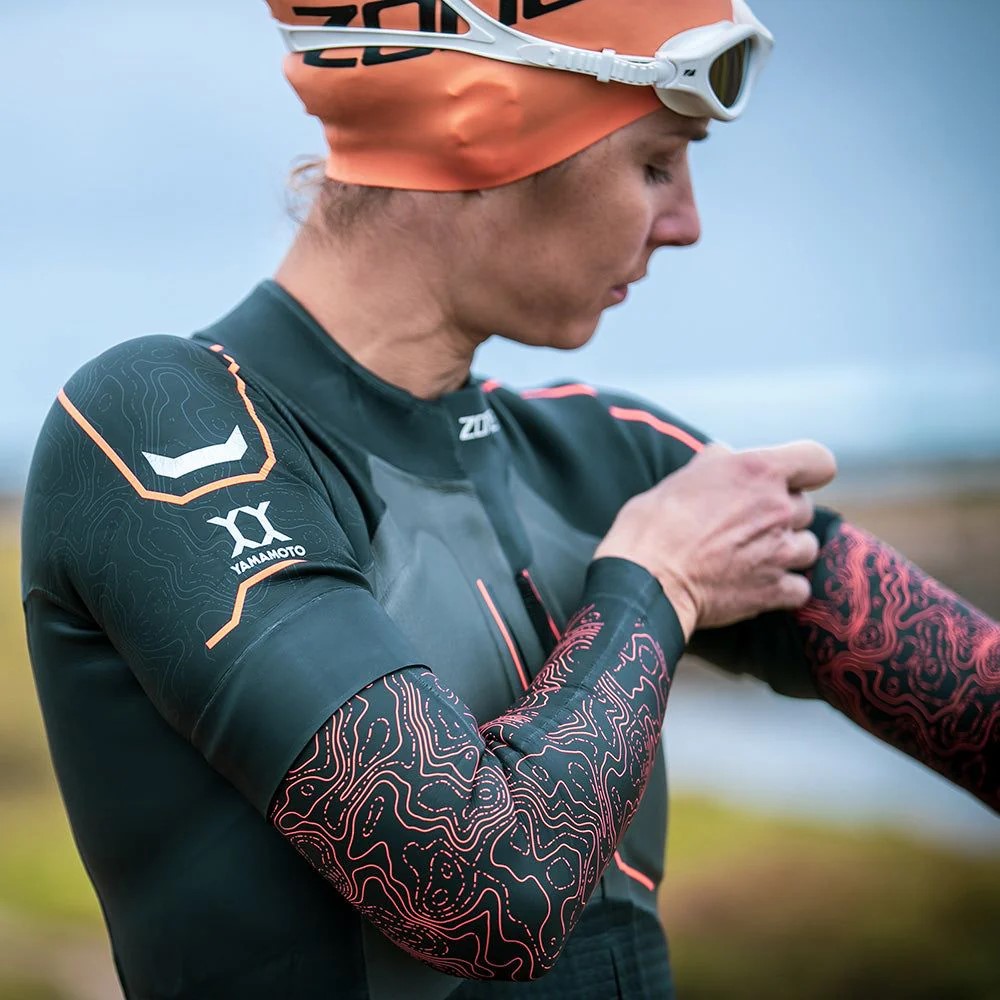
SwimRun FAQ
What is SwimRun?
SwimRun is an endurance sport that combines trail running and open water swimming in a continuous and fluid race format. Athletes move through a series of alternating running and swimming segments, navigating diverse terrains and environments.
How did SwimRun originate?
SwimRun originated in Sweden in 2006 with the first official race called ÖtillÖ, meaning “island to island” in Swedish. The sport was born from a friendly bet between friends challenging each other to race between islands, incorporating both running and swimming.
How are SwimRun events structured?
SwimRun events are typically structured as a series of trail running and swimming segments. Unlike triathlons, transitions between running and swimming are continuous, requiring athletes to adapt to varying terrains and water conditions.
What kind of teams participate in SwimRun?
Teams of two are common in SwimRun events. Teammates are often tethered together during the swim segments for safety and support. The sport encourages teamwork, fostering a sense of camaraderie among participants.
What equipment is required for SwimRun?
Key equipment includes a wetsuit designed for both swimming and running, trail running shoes with good drainage, a tow line to connect teammates during swims, and optional tools like paddles and pull buoys to aid swimming.
Are SwimRun events suitable for beginners?
Yes, SwimRun events cater to participants of various skill levels. Some races offer shorter sprint distances, making them accessible to beginners, while others provide more challenging courses for experienced athletes.
Can I participate in SwimRun as a solo athlete?
While SwimRun is typically a team sport, some events offer solo categories. However, the majority of races emphasize the teamwork aspect, with participants tethered during swims.
What kind of terrain and environments are common in SwimRun races?
SwimRun courses can vary widely, taking participants through coastal areas, lakes, archipelagos, and challenging trails. Athletes may encounter rocky terrain, dense forests, and varying water conditions, adding an element of adventure to the races.
How is safety ensured in SwimRun events?
Safety is a priority in SwimRun events. Athletes are often required to wear safety gear, and race organizers implement measures such as lifeguards, medical support, and mandatory pre-race briefings to ensure a secure racing environment.
How can I get started with SwimRun?
To get started with SwimRun, consider finding a local event or training group. Invest in the necessary equipment, practice swimming in open water, and build both running and swimming endurance. Joining the SwimRun community can provide valuable insights and support as you embark on this thrilling endurance journey. Get a structured training plan for example those on TrainingPeaks and Final Surge.
Can I use a traditional wetsuit?
A SwimRun-specific wetsuit is recommended, as it allows better movement and easier ventilation compared to a standard triathlon wetsuit.
Do I change shoes between segments?
No, you wear the same lightweight, quick-draining shoes throughout the entire race.
How do I transition between swimming and running?
There are no formal transition zones; you simply exit the water and start running immediately. Practicing seamless transitions is key to efficiency.
What if I’m not a strong swimmer?
Many SwimRun races have manageable swim distances, and using a pull buoy or hand paddles can aid buoyancy and propulsion.
How do I stay safe in open water?
Train in open water to get comfortable with waves and currents. Always follow race safety requirements, such as wearing a whistle and swimming in designated areas.
Where can I find SwimRun events?
Check out SwimRun-specific websites and federations, such as ÖTILLÖ or local endurance event listings.
What should I eat during a SwimRun?
Fuelling strategies vary, but energy gels, hydration packs, and aid stations along the route help maintain energy levels.
Is SwimRun suitable for beginners?
Absolutely! Many sprint-distance events cater to beginners, offering a great way to experience the sport without long distances.
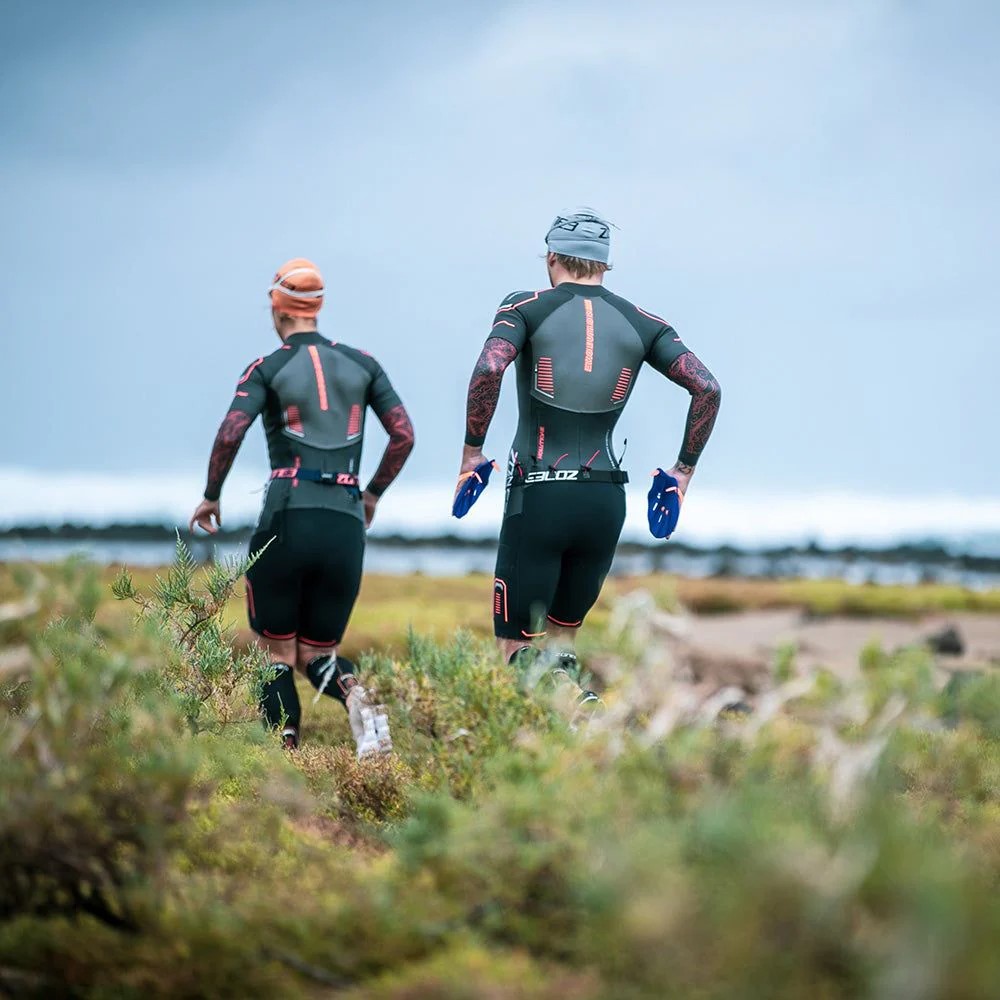
This website uses affiliate links which may earn a commission at no additional cost to you. As an Amazon Associate I earn from qualifying purchases. which may cover part of a cup of coffee for me to fuel my training.

